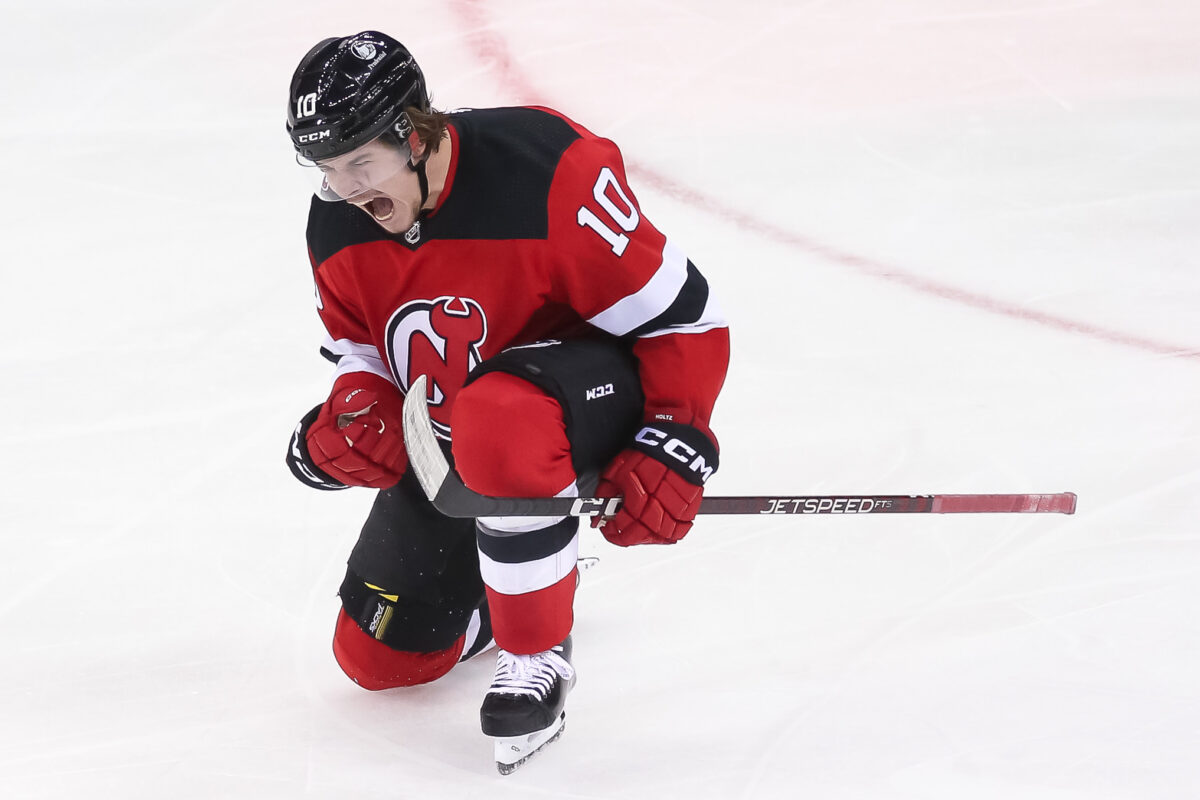New Jersey Devils general manager Tom Fitzgerald was one of the lucky ones. When he settled into his seat on the plane to leave Las Vegas, he had significantly more money to spend than when he landed just four days earlier. Armed with nearly $20 million in cap space, he now heads home to finish remaking his team in the image of a modern Stanley Cup champion.
Related: New Jersey Devils’ 2024 NHL Free Agency Guide
Fitzgerald has taken bold steps moving on from three immensely popular players in John Marino, Alexander Holtz, and Akira Schmid, especially when the return was, on its face, just Paul Cotter and a bevy of draft picks. Moving on from Marino and Holtz can be seen as an admission of failure on behalf of the general manager. Trading Schmid resulted from an abundance of depth at the position and gave the goalie an opportunity in an organization where his path to the NHL was clearer.
Just a year ago, Marino seemed like a premier shutdown defender who could provide secondary offense and was an excellent puck mover. By the end of this season, Marino’s inconsistency was exposed. The once stalwart defender was now a liability and failed to raise his game when the team needed it most with the injuries to Dougie Hamilton and the influx of rookie defensemen. Marino consistently had difficulty securing the crease, often ending up on the wrong side of an opposing forward, leading to weakside tap-in goals. Fitzgerald has signaled a desire to get stronger and more physical, which, coupled with the emergence of Simon Nemec, is the context for trading Marino.
Holtz had a similar trajectory, falling from the seventh overall pick in 2020 to being relegated to fourth-line minutes. Despite an unfailing loyalty from a fan base yearning for him to succeed, Holtz could not break through and raised the organization’s ire. He needed a fresh start after failing to succeed under two head coaches and being cut from the Swedish National Team for the IIHF World Championship. What Holtz ultimately becomes remains to be seen and will depend on his growth off the puck, but it became apparent that it would not happen in New Jersey. Fortunately, age is still on his side, even if he hasn’t put it all together.

As Fitzgerald ambled down the jetway that welcomed him back to Newark, he had to know that the most consequential decisions of his Devils’ tenure lay ahead in the space between touching down and the start of Independence Day. In that time, he will need to reshape a roster in an image built to shepherd his talented core into their contention era. He is rumored to be connected to at least two defensemen, but that only scratches the surface of the team’s needs. New Jersey currently has 17 players signed to the NHL roster. In the next few days, they need to replace Marino and Kevin Bahl, add two middle-six forwards, and finish remaking the bottom six.
With the tenth overall pick used, their 2025 first-round pick, Schmid, Holtz, and Marino traded, the Devils have depleted much of their trade capital and will need to fill their needs in the free-agent market unless they are prepared to move another roster player with value. Here is how they can fill their holes in free agency while staying within the bounds of the salary cap.
Defense Wins Championships
The last two Stanley Cup champions have not only featured superstar American forwards but, most importantly, suffocating veteran defenses whose consistency drove the teams through the inherent offensive inconsistencies that come during a deep playoff run. Fitzgerald deserves credit for recognizing that while both Bahl and Marino are serviceable NHL defensemen, neither was the correct fit moving forward as the team progressed. The team desperately needs Bahl’s size and physicality, but with the youth of Luke Hughes and Nemec, it could not afford to rely on a third rookie defenseman as its shutdown defender. Marino is a bonafide middle-pair NHL defenseman, but his style of play is redundant when Nemec is factored in, and the Devils seem to believe there are more complete players available in free agency.
Replacing John Marino in the Top 4
The worst-kept secret in the NHL is that Brett Pesce is headed to New Jersey to replace Marino. The Carolina Hurricanes have traded away the signing rights to Jake Guentzel, so they may try to circle back and keep Pesce, but from all accounts, he will be a Devil come noon on July 1.
Over the course of the last two seasons, Pesce outpaced Marino in almost every category. Despite playing 13 more games, he was on the ice for 15 fewer high-danger goals against and three goals total at 5v5. With Pesce on the ice, the Hurricanes played to a .909 save percentage (SV%), while the Devils played to an .897 SV% with Marino. The disparity is even starker on the penalty kill. Marino played just over 50 more penalty-kill minutes than Pesce and was on the ice for 19 more goals against. Despite their expected goals against per 60 minutes being nearly identical, with Pesce on the ice, the Hurricanes surrendered more than two fewer goals per 60 minutes than the Devils did with Marino. Their hits are even on the kill, but Pesce blocked more than twice as many shots as Marino.

Pesce is the quintessential second-pair defenseman for Sheldon Keefe’s preferred style and could be the perfect foil for Hughes. A two-way defender who provides some secondary offense, Pesce notably uses his size while controlling his net front and zone entries. He is masterful at doing small things well. Compared to Marino, he gave the puck away almost half as much, blocked twice as many shots, drew more penalties, and took fewer hits. Carolina deployed him as a matchup defender due to the simplicity of his game in the defensive zone, his efficiency in killing rushes, and his clean zone exits shift after shift against the opponent’s best forwards. Pesce is also an excellent shot blocker and a premier penalty killer. Should the Devils want to invest, he could be an integral part of their contention window.
If Carolina finds a way to keep Pesce with the money they saved from Guentzel or New Jersey gets out-bid at the final minute, they would have to scramble, but there are potential replacements. The main option would be Matt Roy, who has already announced he will be testing free agency. Roy, a 29-year-old player who averages 24 points, 139 hits, and 148 blocks per 82 games and is a career plus-106, should be considered if the Devils want to supplement their top four absent Pesce. He is also projected to come a few hundred thousand cheaper.
Finding a Replacement for Kevin Bahl
Coming into this season, Bahl spoke often about the opportunity presented to him by the departure of Ryan Graves. He hoped to demonstrate that he could assume the left-side shutdown minutes not taken by Hamilton’s partner Jonas Siegenthaler. While Bahl took on increased minutes and opportunity, he showed he was not a finished product and likely not the physical stopper the Devils needed. His inability to grab that role and make it his own led to his trade and opened up a spot the Devils will have to fill in free agency. They have internal options, but if they were unwilling to continue with Bahl, it is difficult to see Fitzgerald agree to go forward with another unproven defenseman.
Fortunately for the Devils, several options are available on the market and in trade. The best fit for New Jersey is Brenden Dillon. He solves all their issues in the spot vacated by Bahl. Dillon resembles former Devil Graves in size at 6-foot-4 and 220 pounds but is a better, faster skater than Graves (per NHL Edge) and brings more edge and aggression. Dillon has never been shy about standing up for his teammates. This season, he participated in seven fights, many of which were in response to liberties taken by opponents on other Jets. He is also a premier penalty killer and plays shutdown defense without sacrificing mobility and the ability to move the puck. He averages 198 hits and 110 blocks while remaining durable, having played at least 76 games every full season since his rookie year.
If Dillon chooses to sign elsewhere, then New Jersey will have a few other options. Joel Edmundson played well for Toronto in the playoffs and has the size and aggression the team wants, but he does have durability issues. The Vancouver Canucks may not have enough space to bring back Ian Cole, and he could be a short-term fit in New Jersey at a lower cost than Dillon. Another interesting choice would be to reunite with Florida Panther Dmitry Kulikov, who is not as big or physical as the others but did just prove in the playoffs that he can be a third-pair defenseman on a Cup winner. Should he have to go the trade route, Fitzgerald should look to try to pry one of the Vegas defensemen loose, as they are up against the cap.
Diversifying the Forward Portfolio
Fitzgerald has been on record saying that he believes his forward group was too alike and too vanilla. He started addressing that by jettisoning Holtz in favor of a player with snarl in Cotter. The Devils have holes on three of their four lines. The Timo Meier, Nico Hischier, and Jesper Bratt line seems complete, and Jack Hughes, Dawson Mercer, Ondrej Palat, Erik Haula, Curtis Lazar, Cotter, Nathan Bastian, Kurtis MacDermid, and Nolan Foote are in contention for the remaining spots. Hughes, Mercer, Palat, and Haula seem destined for the top nine. Today’s fourth line would be some amalgamation of Cotter, MacDermid, Bastian, and Lazar, a group that would be a nightmare on the forecheck.
Replacing Holtz and Tyler Toffoli
Last season the Devils traded for veteran Tyler Toffoli to add a right-hand shot veteran to their top six. Toffoli was seen as a bridge before Holtz could take over. He held up his end of the bargain by nearly scoring 30 goals for New Jersey before being traded away at the deadline for draft picks. Holtz never found a permanent role in the top six, and with his trade, the hole remains.
The Devils have several options for shifting their lines to accommodate matchups and personnel. With Steven Stamkos set to hit free agency, the Devils could kick the tires on the two-time Stanley Cup champion and be able to pay him what Tampa has thus far declined. The concern with Stamkos is the cap hit and his age, but getting a player of his caliber in the room would be worth going a bit above New Jersey’s budget and offsetting it elsewhere.
Jonathan Marchessault is the other forward who would be a perfect fit for New Jersey. Despite being undersized, he is a fierce player known for delivering in the clutch, with more than ten percent of his career goals being game-winners. He is coming off of a 42-goal season as a follow-up to his Conn Smythe Trophy-winning playoff performance. He is only available because of Vegas’ cap issues, and should he make it to market, he would be a guy that the Devils should focus on. He brings the right shot they desperately need in their top six, and he thrives at even strength, having scored at least 15 even-strength goals in the last eight seasons.

The free agent class is not chock full of high-end forwards, but those would be outside New Jersey’s budget. With Matt Duchene likely off the market and staying in Dallas, the Devils could look at players like Adam Henrique, who would be able to play throughout the middle six and take important draws. If the Devils want a more traditional wing, pivoting to Viktor Arvidsson makes sense. He adds a right-handed shot, plays fast and strong along the boards, and can slide throughout the lineup. Arvidsson would bring scoring as well, averaging 27 goals per 82 games.
Several other players aren’t exact replacements but could fit the top/middle six role. One is Vladimir Tarasenko, a two-time Cup champion who was cited by Panthers head coach Paul Maurice for his leadership skills in their run through the playoffs. This season, Tarasenko proved at 32 that he can still play high-level hockey and quelled any durability concerns. Anthony Duclair’s speed would tantalize the Devils fan base on a line with Hughes and Mercer or Bratt. He showed he is healthy this season after tearing his Achilles tendon two years ago and proved that his scoring translated in all situations for San Jose and Tampa.
There is a trio of Hurricanes hitting the market that could each help New Jersey in different ways. Former Devil Stefan Noesen is a right-shot player who brings snarl, size, and sneaky scoring. He would be an ideal member of the new look bottom six that Fitzgerald is touting. Jordan Martinook is more of a traditional middle-six winger who is an elite defensive player but can play up and down the lineup. With Martinook on the ice in the playoffs, the Hurricanes played to a .935 SV%. The final Hurricane winger is Teurvo Teravainen. A Cup winner in the early part of his career in Chicago, he is a versatile player who can also play up and down the lineup and has speed to burn. A guy his teammates call Turbo, who is plus-107 for his career, certainly fits the mold of what the Devils are looking to do.
The Devils could also turn to useful, scrappy Jason Zucker, who could play both wings in the middle six. He adds speed, bite, and a knack for goal-scoring. In 2022-23, he scored 48 points in 69 games for the Pittsburgh Penguins before leaving in free agency for the Arizona Coyotes, who ultimately moved him to Nashville at the deadline, where he was an important contributor in guiding them to the playoffs. Zucker is not huge, but he does not back down from physical confrontations, averaging over 100 hits per 82 games in his career.
Fourth Line Reinforcements
All decisions this time of year are interconnected. With the ceiling of the salary cap looming, the Devils are not in a position to recklessly throw money around. They could ice a fourth line of Bastian, MacDermid centered by Lazar, and play Cotter on the third line, allowing them to focus their spending on defense and the top nine. Ideally, they would add a bonafide 4C to the fold like a Kevin Stenlund. They could also go bargain shopping from the other finalists and try to sign Mattias Janmark who had an excellent playoff showing as a fast, defense-first forward who could change games on the penalty kill.
The Devils prospect pool lacks high-end forward depth but has players who appear ready to contribute to an NHL roster. New Jersey could use Nolan Foote and/or Brian Halonen as bottom-six wingers to save cap space. Both play a heavy-style game, Halonen is a better skater, and Foote possesses an NHL-quality shot and would provide secondary offense. Using these two to plug holes and taking a shot on a player like Stenlund, Janmark, or Brandon Duhaime. Duhaime is an intriguing option. He won’t provide much secondary offense, but he can put up 15 to 20 points. His speed should not be overlooked either. In the playoffs, his top speed of 22.73 mph put him in the 91st percentile of all forwards. He ranked in the 87th percentile for speed bursts in the playoffs over 20 mph. Couple that with 555 hits in 211 career games; he is a fit.
Fitzgerald has chosen to rebuild his team from the crease outward. It is probably the only way New Jersey can sustain winning for the entirety of the Hughes/Hischier window. Now that he has created roster space and cap space, the time is right to be aggressive on the free agent market to lock up a top-four defenseman, a top-six winger, a bottom-pair defenseman, and a bottom-six forward. Adding those four ingredients will diversify the Devils and deliver to Keefe the most complete team he has ever coached at the NHL level.
